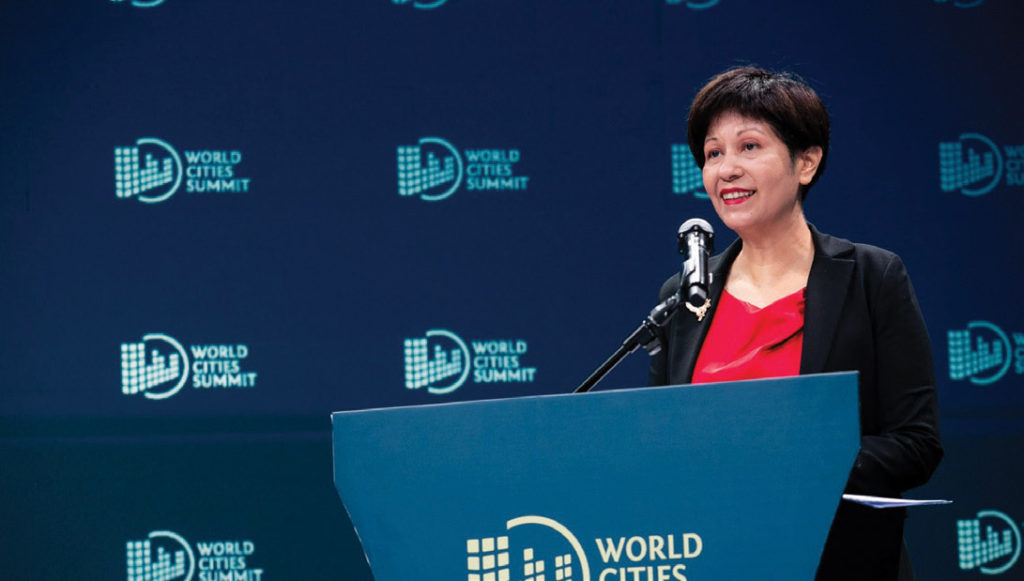3rd Quarter 2021
World Cities Summit 2021: Nature, Urban Resilience and Equitable Development
September 17, 2021

Minister Indranee Rajah 
Dr Cheong Koon Hean
The World Cities Summit (WCS) 2021, jointly organised by Singapore’s Centre for Liveable Cities and the Urban Redevelopment Authority, held the first part of its virtual event from 21 to 23 June 2021 that attracted approximately 2,500 delegates from 337 cities. Most of the topics discussed revolved around building resilience in cities and tackling disruptions and crises.
Here, FuturArc zooms in on the fundamental need for cities to take a long-term view to ensure that developments are no longer just sustainable, but also restorative and equitable.
Building Resilience
The panels and discussions underscored the importance of building resilience amongst communities, businesses and governments to emerge stronger from the COVID-19 pandemic. Leaders joining the summit included David Malpass, President of the World Bank; Carrie Lam, Chief Executive of Hong Kong SAR; Sally Capp, Lord Mayor of Melbourne;
Yang Baojun, Chief Economist, Ministry of Housing and Urban-Rural Development of China; Ridwan Kamil, Governor of West Java and many more. They concurred that resilience is the key to navigating uncertainty. Indranee Rajah, Minister at the Prime Minister’s Office, Second Minister for Finance and Second Minister for National Development of Singapore, also shared about developing infrastructure that produces equitable outcomes and investment that does not leave anyone behind.
The participants agreed that the pandemic has accelerated digitalisation across industries and brought the climate agenda to the forefront. Cities around the world have to review their urban plans in preparation for a post-pandemic city. Nature also needs to be ‘brought back’ and woven into the urban fabric to strengthen resilience against climate change.
Restoring Nature
In her presentation, Dr Lena Chan, Senior Director of the International Biodiversity Conservation Division of the Singapore National Parks Board, told the audience about how Singapore has developed from a Garden City to a City in Nature.
She believes that restoring nature back into the city is necessary for the liveability, sustainability and well-being of the people; and that applying nature- based solutions is necessary in achieving climate, ecological and social resilience. Key strategies include extending natural capital; intensifying nature in gardens and parks; and strengthening connectivity between green spaces.
For example, Bukit Timah occupies a mere 0.2 per cent of Singapore area, but holds 55 per cent of the flora species. To preserve nature when a road was built between Bukit Timah Nature Reserve and the Central Catchment Reserve, ecological connectivity was also constructed. Within five to six years, the eco-link’s lush greenery has become a thriving sanctuary for the local animals.
An example of how nature-based solutions can help mitigate floods and restore ecosystem services is the naturalisation of the river that runs through Bihsan-Ang Mo Kio Park. A concrete drain without naturalisation would be serving only one function, i.e., flood mitigation; but a naturalised waterway offers ecosystem services by way of providing habitats for biodiversity as well as social spaces for the community—allowing nature to do its work as it were, without much ‘built interference’, while fostering deeper man-nature relationships.
Focusing on Reforestation
Nevertheless, nature in cities should be accompanied with optimum reforestation efforts in the tropics in order to reduce carbon emissions significantly on a global level. Koh Lian Pin from the Centre for Nature- Based Climate Solutions at the National University of Singapore, reported that the global CO2 emissions are currently at about 40 billion tonnes per year, including the annual emissions in China, the United States, Indonesia and Singapore.
Protecting threatened forests across the tropics can avoid the loss of almost 2 billion tonnes of CO2 per year already—which is greater than the emissions of Indonesia and Singapore combined.
[This is an excerpt. Subscribe to the digital edition or hardcopy to read the complete article.]
Read our latest City Profiles:
Read more Cities stories:
To read the complete article, get your hardcopy at our online shop/newsstands/major bookstores; subscribe to FuturArc or download the FuturArc App to read the issues!
Previously Published Happening
Contact us at https://www.futurarc.com/contact-us for older articles.
